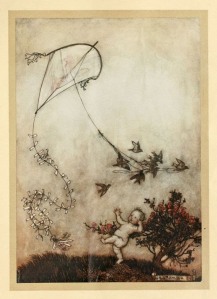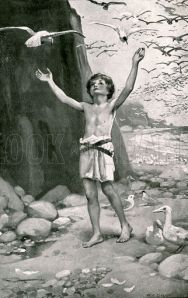In reading Peter Pan in Kensington Gardens, I was reminded of The Water Babies. Solomon tells Peter that he is a “Betwixt-and-Between” (Barrie, 17) and it seems to me that in The Water-Babies, Tom is equally stuck being not-quite human.
I think the scene that really made the connection for me though, was the scene with the birds in Peter Pan; it reminded me of the Allfowlsness Island Tom encounters on his journey. On an island of birds – each having their own community and way of life – both protagonists find themselves out of place; Tom is looking to continue on his journey to regain his his humanity and Peter is stuck their after losing his ability to fly.
The islands of birds play different yet similar roles as stop-overs on the protagonists journeys of self-growth and development. For starters, both are sanctuaries from humanity. In Water Babies, the petrels tell Tom never to reveal the island’s location “lest men should go there and shoot the birds, and stuff them, and put them into stupid museums…” (Kingsley, 145). Likewise, in Peter Pan, Solomon’s island in Kensington Gardens is only reachable by air: “for the boats of humans are forbidden to land there, and there are stakes around it, standing up in the water, on each of which a bird sentinel sits by day and night” (Barrie, 16).
The protagonists, stranded, must find a way off of each island. At these points of their respective stories, the protagonists’ goals are the same; both Tom and Peter are – even if not in the same ways – trying to become real humans again. Unfortunately – or perhaps fortunately depending on perspective – only one of the two succeeds in this quest. While Tom regains his humanity and is better of than when he began, Peter is replaced by his family and spends his eternal youth playing in the gardens, perpetually stuck between being an animal and a man.





